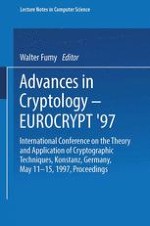1997 | OriginalPaper | Buchkapitel
Oblivious Transfers and Privacy Amplification
verfasst von : Gilles Brassard, Claude Crépeau
Erschienen in: Advances in Cryptology — EUROCRYPT ’97
Verlag: Springer Berlin Heidelberg
Enthalten in: Professional Book Archive
Aktivieren Sie unsere intelligente Suche, um passende Fachinhalte oder Patente zu finden.
Wählen Sie Textabschnitte aus um mit Künstlicher Intelligenz passenden Patente zu finden. powered by
Markieren Sie Textabschnitte, um KI-gestützt weitere passende Inhalte zu finden. powered by
Assume % MathType!MTEF!2!1!+- % feaafiart1ev1aaatCvAUfKttLearuqr1ngBPrgarmWu51MyVXgatC % vAUfeBSjuyZL2yd9gzLbvyNv2CaeHbd9wDYLwzYbItLDharyavP1wz % ZbItLDhis9wBH5garqqtubsr4rNCHbGeaGqiVu0Je9sqqrpepC0xbb % L8F4rqqrFfpeea0xe9Lq-Jc9vqaqpepm0xbba9pwe9Q8fs0-yqaqpe % pae9pg0FirpepeKkFr0xfr-xfr-xb9adbaqaaeGaciGaaiaabeqaam % aaeaqbaaGcbaWefv3ySLgznfgDOfdarCqr1ngBPrginfgDObYtUvga % iyaacqWFaeFqaaa!460E! $$ \mathcal{A} $$ owns two secret k-bit strings. She is willing to disclose one of them to % MathType!MTEF!2!1!+- % feaafiart1ev1aaatCvAUfKttLearuqr1ngBPrgarmWu51MyVXgatC % vAUfeBSjuyZL2yd9gzLbvyNv2CaeHbd9wDYLwzYbItLDharyavP1wz % ZbItLDhis9wBH5garqqtubsr4rNCHbGeaGqiVu0Je9sqqrpepC0xbb % L8F4rqqrFfpeea0xe9Lq-Jc9vqaqpepm0xbba9pwe9Q8fs0-yqaqpe % pae9pg0FirpepeKkFr0xfr-xfr-xb9adbaqaaeGaciGaaiaabeqaam % aaeaqbaaGcbaWefv3ySLgznfgDOfdarCqr1ngBPrginfgDObYtUvga % iyaacqWFSeIqaaa!456B! $$ \mathcal{B} $$, at his choosing, provided he does not learn anything about the other string. Conversely, % MathType!MTEF!2!1!+- % feaafiart1ev1aaatCvAUfKttLearuqr1ngBPrgarmWu51MyVXgatC % vAUfeBSjuyZL2yd9gzLbvyNv2CaeHbd9wDYLwzYbItLDharyavP1wz % ZbItLDhis9wBH5garqqtubsr4rNCHbGeaGqiVu0Je9sqqrpepC0xbb % L8F4rqqrFfpeea0xe9Lq-Jc9vqaqpepm0xbba9pwe9Q8fs0-yqaqpe % pae9pg0FirpepeKkFr0xfr-xfr-xb9adbaqaaeGaciGaaiaabeqaam % aaeaqbaaGcbaWefv3ySLgznfgDOfdarCqr1ngBPrginfgDObYtUvga % iyaacqWFSeIqaaa!456B! $$ \mathcal{B} $$ does not want % MathType!MTEF!2!1!+- % feaafiart1ev1aaatCvAUfKttLearuqr1ngBPrgarmWu51MyVXgatC % vAUfeBSjuyZL2yd9gzLbvyNv2CaeHbd9wDYLwzYbItLDharyavP1wz % ZbItLDhis9wBH5garqqtubsr4rNCHbGeaGqiVu0Je9sqqrpepC0xbb % L8F4rqqrFfpeea0xe9Lq-Jc9vqaqpepm0xbba9pwe9Q8fs0-yqaqpe % pae9pg0FirpepeKkFr0xfr-xfr-xb9adbaqaaeGaciGaaiaabeqaam % aaeaqbaaGcbaWefv3ySLgznfgDOfdarCqr1ngBPrginfgDObYtUvga % iyaacqWFaeFqaaa!460E! $$ \mathcal{A} $$ to learn which secret he chose to learn. A protocol for the above task is said to implement One-out-of-two String Oblivious Transfer, denoted (12)-OTk. This primitive is particularly useful in a variety of cryptographic settings. An apparently simpler task corresponds to the case k = 1 of two one-bit secrets: this is known as One-out-of-two Bit Oblivious Transfer, denoted (12)-OT. We address the question of reducing (12)-OTk to (12)-OT. This question is not new: it was introduced in 1986. However, most solutions until now have implicitly or explicitly depended on the notion of self-intersecting codes. It can be proved that this restriction makes it asymptotically impossible to implement (12)-OTk with fewer than about 3.5277k instances of (12)-OT. The current paper introduces the idea of using privacy amplification as underlying technique to reduce (12)-OTk to (12)-OT. This allows for more efficient solutions at the cost of an exponentially small probability of failure: it is sufficient to use slightly more than 2k instances of (12)-OT in order to implement (12)-OTk. Moreover, we show that privacy amplification allows for the efficient implementation of (12)-OTk from generalized versions of (12)-OT that would not have been suitable for the earlier techniques based on self-intersecting codes. An application of this more general reduction is given.
